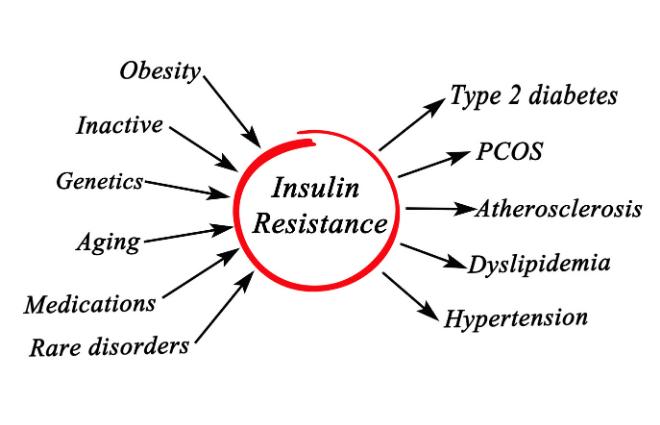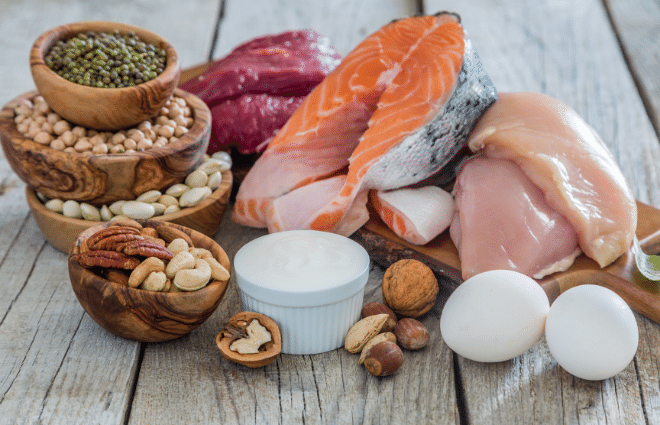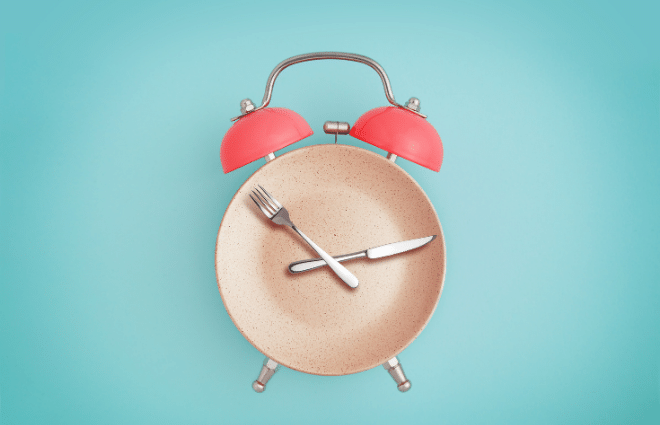Finally Lose Weight With the Insulin Resistance Diet
We all know losing weight is hard, no matter how motivated you are.
But if you feel like it’s especially difficult for you, even if you do everything by the book, then there might be bigger health issues at play.
The CDC estimates that about 1 in 3 Americans are prediabetic, which also means even more people than that are insulin resistant.
Being insulin resistant causes a whole host of health problems, including diabetes and cardiovascular disease–but it also makes it very hard to lose weight.
Fortunately, you can reverse insulin resistance with the right diet and exercise.
We’ll tell you everything you need to know about what insulin resistance is, how to figure out if you have it, and how to get it in check so you can finally lose weight and reclaim your health.
But first, let’s go over how people become insulin resistant in the first place.
This post may contain affiliate links, which helps keep this content free. Please read our disclosure for more info.
What the Heck Is Insulin Resistance, Anyway?
When you eat food, your body turns it into energy—and its favorite quick energy source is glucose, or sugar.
Then, your pancreas produces a hormone called insulin and sends that out to carry the glucose from your bloodstream and into your cells.
However, sometimes your cells become less receptive to insulin and stop absorbing the sugars.
This can happen for a number of reasons (more on that in a moment), but the end result is the same:
- your pancreas has to work overtime to produce more insulin,
- your cells become increasingly resistant to absorbing it,
- your body starts storing the excess (unabsorbed) glucose as fat in odd places,
- and you end up overweight, exhausted, and hopeless.
If you don’t change your diet and lifestyle at this point, you will eventually develop prediabetes, and then type 2 diabetes.
But even before you reach prediabetes, insulin resistance increases your risk of cardiovascular disease, stroke, cancer, age-related diseases like dementia, and of course, weight gain and obesity.
In the spirit of silver linings, your stubborn fat that you just can’t get rid of might actually save your health—if you can make the necessary changes now before things go too far south.
And if you’ve already developed type 2 diabetes, there is still hope! Unlike type 1 diabetes, type 2 diabetes can be reversed with proper diet and exercise.
So no matter what stage of insulin resistance you’re at, it following the insulin resistance diet can make your body receptive to insulin again, and help you finally lose weight.
What Causes Insulin Resistance?

So, how did it come to this??
For many people, simply having excess body fat—especially belly fat—can lead to insulin resistance, which in turn contributes to more body and abdominal fat, creating a vicious cycle. (1)
Of course, you had to have a few bad habits in the first place that led to that excess fat.
One of the most common causes or risk factors in developing insulin sensitivity is a diet high in carbs and sugars, since every time you eat those foods, a huge rush of glucose is sent into your bloodstream–and your pancreas has to scramble to keep up.
And if you live in the USA, your high-carb diet habits may not be entirely your fault.
Remember the food pyramid you learned about in grade school?
Although it has been revised a few times since its inception in the 1950s, the so-called “Standard American Diet” (SAD for short) that product labels and nutritionists base daily recommended food intake from suggests getting 50% of your daily caloric intake from carbs. Yikes! (2)
Pair that kind of diet with a sedentary lifestyle, and your muscles certainly won’t be looking for extra energy—meaning they are much less willing to absorb that glucose and insulin.
There are also some other factors that put you at an increased risk of developing insulin resistance, including:
- Being over age 45
- Apple-shaped body, rather than pear or hourglass
- Having a history of gestational diabetes, heart disease, stroke, PCOS, or other hormonal disorders
- High blood pressure or abnormal cholesterol
- Physical inactivity
- Sleep problems
- Family history of diabetes
- Certain ethnicities
- Some medications
How to Tell if You are Insulin Resistant

Other than weight gain and fat that you just can’t get rid of, there aren’t many major symptoms until insulin resistance progresses to diabetes.
Some people develop dark spots on their armpits, neck, or back, but only if the insulin resistance is severe.
Most people who are insulin resistant report feeling tired, and having an increased appetite–which are unfortunately pretty vague symptoms.
You know your body best though–so if you feel more tired than you should, and you have a hard time feeling satiated or refreshed after a meal, check your blood sugar.
Blood tests can confirm if you are insulin resistant, and we do recommend checking in with your doctor to make sure you haven’t developed a more serious health condition.
Just make sure to request a check of your A1C levels, since standard blood panels may not include that test.
If you can’t get to the doctor right away, the next best way to check for insulin resistance is simply to try the insulin resistance diet, and see how your body reacts.
The Insulin Resistance Diet for Weight Loss
Ah yes, that thing that most likely got you here in the first place.
It can be hard to change your diet, especially if you’re used to eating processed or fast foods, or if you have a major sweet tooth.
Changing your lifestyle is no easy feat—but losing weight can absolutely save your life.
In fact, according to Melissa Dierks, RDN, LDC, CDCES, “A weight loss of 7-10% your current body weight can help prevent pre-diabetes from developing into type 2 diabetes. So, if you weigh 250 lbs., even a 17 lb. weight loss can make a difference.”
Additional research shows that for every two pounds you lose, your risk of developing diabetes drops by 16%. (3)
Here are the steps to eating a proper diet to reverse insulin resistance:
Go on a Carb Detox

Cut out carbs for at least a week or two, especially added sugars and simple carbs, and even including potatoes, legumes, and rice.
Your body needs a chance to rest and recover after speed-processing glucose for so long.
Give your body the break it deserves, and see how well you start functioning once you’ve had time to heal!
Added bonus: Cutting out carbs is sure to help you drop a bunch of weight quickly, especially if carbs and sugar have been a big part of your diet.
Once you’re ready to add carbs back in, stick to high-fiber, complex carbs like beans, whole grains (quinoa, oats, wild rice), and sweet potatoes.
Shop the Outskirts of the Grocery Store

You’ve probably heard that the outer edges of the grocery store are the healthiest areas to shop—and that’s because all of the freshest food is displayed there.
To reverse your insulin resistance, you’ll need to eat a lot of veggies—especially green, leafy veggies like broccoli, kale, and spinach.
You can eat fruit, but only in moderation since it still has sugar. Stick to high-fiber or low-sugar fruits like berries and avocados, rather than bananas and grapes.
These fresh, fiber-filled foods have a low glycemic index–and that’s exactly what you should be looking for when trying to reverse insulin resistance.
Determining the glycemic index of foods can help you understand how quickly your food will turn into glucose in your bloodstream, so you can choose your meals wisely.
Foods that have a high glycemic index are rapidly converted into glucose, which translates to a sudden spike in blood sugar. This means your body has to work harder to process the sudden dump of glucose in your system, which is exactly what you should avoid if you’re trying to reverse insulin resistance.
Instead, you should look for foods with a low glycemic index, which are digested more slowly, releasing a slow, steady stream of glucose into your system.
In addition to green veggies and fibrous fruits, foods that are high in protein or have whole grains are also usually low on the glycemic index.
The packaged, shelf-stable, processed foods in the inner aisles of the grocery store tend to have the highest glycemic index–so make sure to stay away from the rows, and shop the fresh, whole foods in the produce and refrigerated sections.
If in doubt, you can do a quick Google search to look up the glycemic index of the foods in question or use a glycemic index calculator.
You’ll want to make sure your food has a glycemic index of no higher than 70, and preferably lower.
Eat Fat to Lose Fat

Although fats are high calorie and have gotten a bad rap over the years, they are actually necessary for weight loss and healthy hormone production. (Did I mention insulin is a hormone?)
You’ll want to avoid trans fats and excess animal fats, such as butter, cream, and fatty cuts of meat; but healthy fats like extra virgin olive oil, avocado oil, and coconut oil are great options.
And in case you’re wondering, even the saturated fat from coconut oil is good for you, and has been shown to aid in reversing insulin resistance.
Fill up on Protein

Eating plenty of protein will help you burn extra calories while giving your body the lasting nutrients and energy it needs, especially when you combine the protein with the veggies we mentioned earlier.
When you replace carbs and sugars with protein and fiber, most people notice an almost immediate increase in energy and mental clarity.
Aim for lean protein like chicken, fish, and lean beef; or a good, clean protein powder, unsweetened Greek yogurt, or nuts and seeds if you’re not a meat-eater.
Just make sure to avoid added ingredients, like hydrogenated oils, sugars, and salt.
Avoid Processed Food

It should go without saying, but processed foods are currently (and hopefully forever) off the menu.
That includes frozen foods that advertise “low glycemic index” or “only three points” or “under 500 calories.”
Those meals are always loaded with additives and extras, and I can guarantee they don’t have enough protein, fiber, or veggies to make a filling meal.
Stay away from processed junk, even if it seems healthy, and opt for whole, fresh foods whenever possible.
I recommend stashing a few lean, high-quality protein drinks in your car or at your desk as a backup for when hunger strikes away from home.
This has saved me many a potential fast-food trip!
Just make sure to look for a protein drink with less than five grams of carbs, no aspartame, and a minimal number of ingredients.
Click here to see one of our favorite high-quality protein drinks on Amazon.
Stop Eating All the Time

I don’t mean to stop eating altogether, but your body deserves a break!
Intermittent fasting has been shown to have a great impact on insulin resistance for a few reasons, not the least of which is the fact that you’ll simply eat fewer calories if you spend less of your waking hours eating.
Taking a chunk of time off of eating each day also gives your body a chance to catch up and process all the glucose in your bloodstream, so it’s not still processing your breakfast by the time you eat lunch.
And you don’t have to take a whole day off of eating.
Try the 16:8 method, where you eat for eight hours of the day, and fast for the other sixteen (eight of which are while you’re sleeping).
For example, you could stop eating at 7:00 pm every night, and then wait until 11:00 am each morning to start eating.
If you feel lightheaded while fasting, or if you start having bad sugar or carb cravings, try drinking black coffee in the morning with a tablespoon of coconut oil blended in.
The caffeine and fat will help quell your cravings and give you an energy boost until your first meal of the day.
Ready to Finally Lose Weight Fast?
If you had lost hope of ever shedding your extra weight, you aren’t alone.
Many of our clients felt exactly the same way before starting our program—hopeless, exhausted, frustrated, and just over weight loss programs that don’t work for them.
We created our 21 Day Fat Loss Challenge for people exactly like you—people who feel like they’ve tried everything under the sun, but just can’t shed the weight or keep it off.

Our challenge provides a step-by-step plan to help you lose up to 21 lbs in just 21 days, with far less effort than you may think!
Tons of our clients have turned it into a lifestyle diet and have lost as much as over 100 pounds with the challenge!
The best part? Besides just losing weight, the 21-Day Fat Loss Challenge was designed to heal your gut, rebalance your hormones, and retrain your tastebuds—so you’ll actually be able to keep the weight off!
If you’re ready to make some changes in your life, this is the ONLY place you should start. We’ll teach you exactly how to make the necessary changes in your diet and lifestyle, and how to keep them “beyond the diet.”
Take control of your life and start your 21 Day Fat Loss Challenge TODAY!
Leave a comment below if you enjoyed this article on the insulin resistance diet, or if you have any questions!

Excellent explanation for the everyday reader of how fat is stored in the body and how to prevent it…
Sounds very interesting. Tried to get the 21 Day Training Guide, but didn’t seem to work. Disappointed.